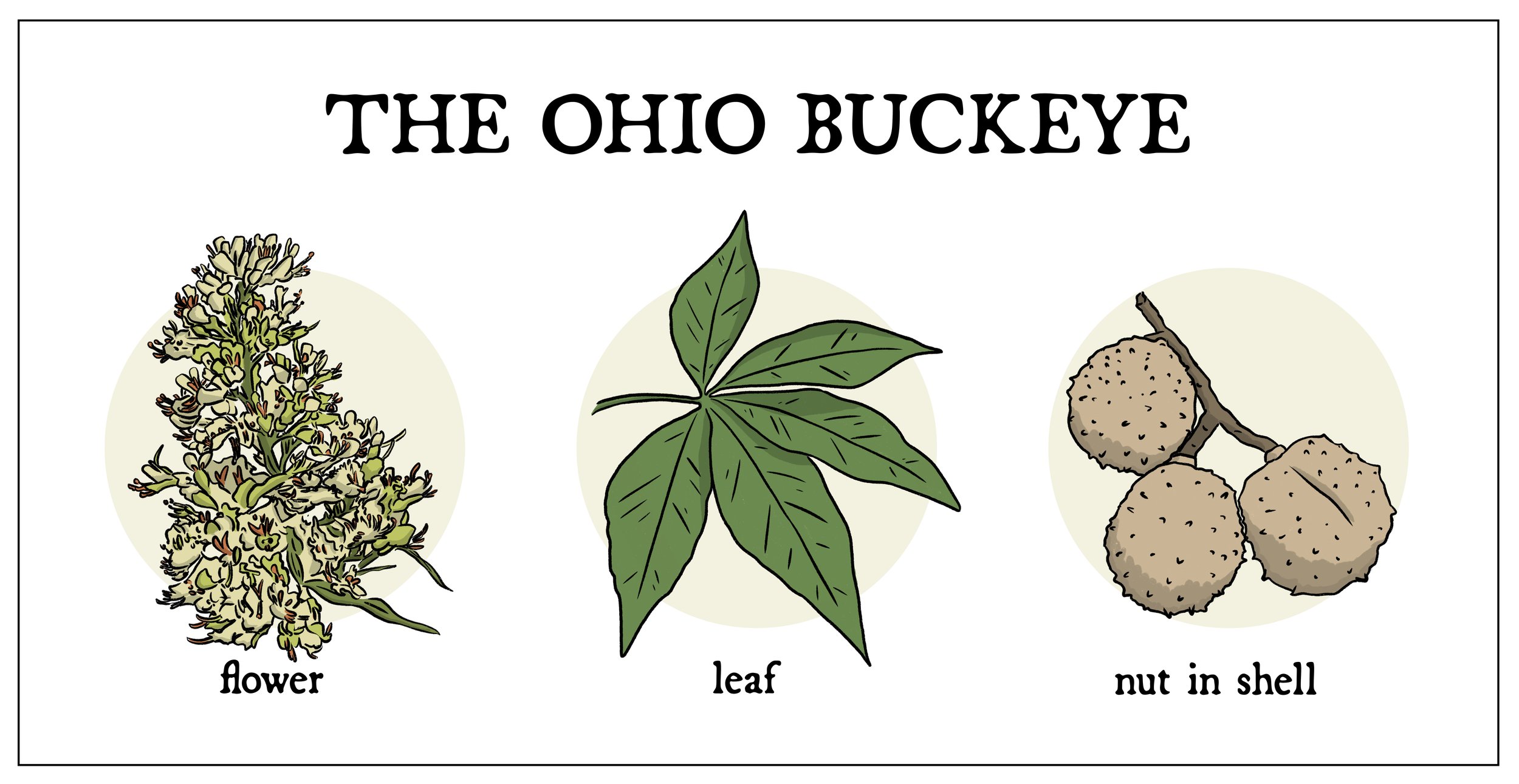Why Are We "Buckeyes?"
By Mike Wilson
ISA Certified Arborist® OH-6806A
August 28, 2025
College football is back! The Ohio State Buckeyes vs the Texas Longhorns face off this Saturday for Week 1. One day, I sat in my family room making buckeye necklaces for friends and family for an upcoming OSU football game and that’s when my curiosity struck. I began to wonder why anyone would call themselves a buckeye. I like to think a team prefers to have a name that intimidates or even scares an opponent, but not us. Many throughout central Ohio consider themselves buckeyes even if they didn’t attend The Ohio State University. However, what does it mean to be a buckeye and why is the identity of Columbus based around this unique nut from a tree? Well, there is actually quite a bit of history surrounding the Ohio buckeye tree (Aesculus glabra) in our beautiful state of Ohio and the story of how it was adopted by our university may not be well known.
[Illustration by Kenny Greer, Russell Tree Experts]
The Ohio buckeye tree has palmately compound leaves, usually comprising of five (occasionally seven) leaflets. The leaves are bright green in the spring and summer, turning to yellow and gold in the fall, creating a stunning display of autumn colors. In the spring, the Ohio buckeye tree produces clusters of small, tubular, greenish-yellow flowers. These flowers are a valuable nectar source for pollinators, including bees and butterflies. The most iconic feature of this tree is the nut, the name of which is thought to be derived from its resemblance to the eye of a deer or a buck’s eye. These nuts are encased in a spiky, leathery husk that splits open in the fall to reveal the glossy, dark brown nut. While they might resemble true chestnuts, it's important to note that buckeye nuts are not edible and can be toxic if ingested.
[Illustration by Kenny Greer, Russell Tree Experts]
Early settlers used these nuts to craft buttons and the trees themselves became valuable for their wood and ornamental qualities. It didn't take long for the buckeye tree to become an integral part of American culture. The first recorded use of the term Buckeye was in 1788 to refer to a settler. Colonel Ebenezer Sproat, who happened to be large in both size and character, was aptly named Hetuck (the Indian word for buckeye) by local natives. He proudly carried the Buckeye nickname for the rest of his life and the label gradually spread to his companions and other local settlers. By the 1830s, writers were commonly referring to locals as “Buckeyes.” The Buckeye nickname became even more commonplace during the 1840 presidential campaign when Ohioan William Henry Harrison was running for president. His supporters wore buckeye-shaped wooden tokens as a sign of their allegiance, and the nickname stuck. Some even believed that carrying a buckeye nut could bring good luck similar to a rabbit’s foot or a four-leaf clover. The buckeye continued to resonate with Ohioans and became the state tree in 1953.
The Buckeye & The Ohio State University
Learn more about the history of Brutus Buckeye
[Illustration by Kenny Greer, Russell Tree Experts]
In the early 1950s, The Ohio State University held a contest to select a new mascot. A student named Dick Doan, who was a cartoonist for the university's student newspaper, suggested the buckeye as a potential symbol because of its significance to Ohio. Prior to this, The Ohio State University hadn’t solidified any formal name. In 1950, The Ohio State officially adopted the name "Buckeyes" and became associated with the university's athletic teams and more. It wasn’t until 1965 that two students, Ray Bourhis and Sally Huber, formalized this tree nut as the official mascot that has been an iconic figure for Ohio State ever since. During this period, schools were known to bring live animal mascots to stadiums and the idea of corralling a live buck didn’t seem like the brightest idea. Instead, they delved back into our state’s historical roots and opted for the simple buckeye nut. An unnamed papier-mâché mascot inspired by the buckeye nut entered Ohio Stadium on October 30th, 1965 during a football game against Minnesota. Shortly afterwards, OSU held a contest to pick a name for the mascot which ultimately led to who we know today as Brutus Buckeye, responsible for the daunting task of rallying fans and encouraging our athletics teams!
Buckeye Grove (pictured above) at The Ohio State University, located just south of Ohio Stadium, is filled with various buckeye trees!
Today, the buckeye is a well-known symbol of The Ohio State University and the buckeye leaf logo is recognized across the country, particularly in the realm of college sports. The buckeye tree and the nuts it produces are closely associated with the state of Ohio and have become a source of pride for OSU and its fans. So next time you’re cheering on our Buckeyes, feel free to quiz those around you to see who really knows why our beloved university chose a toxic nut as a lasting symbol. And as always, go bucks!
[Please note: This article was revised and republished on 8/28/25 from its original publish date of 11/13/23]
ADDITIONAL ARBOR ED™ ARTICLES!
Mike Wilson I Regional Manager, Russell Tree Experts
Mike joined Russell Tree Experts in 2013 and has been in the green industry for 15+ years! He is an ISA Certified Arborist® and a graduate of Oregon State University. Mike is an outdoor enthusiast and a US Army Medic Veteran!











